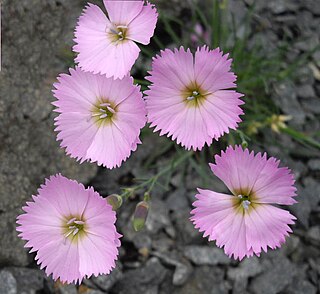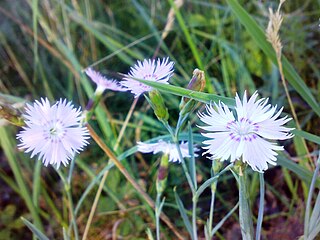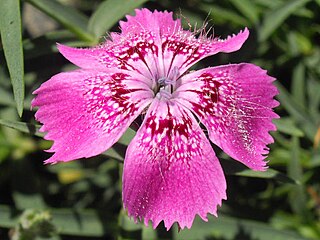
The Royal Horticultural Society (RHS), founded in 1804 as the Horticultural Society of London, is the UK's leading gardening charity.

Dianthus caryophyllus, commonly known as carnation or clove pink, is a species of Dianthus native to the Mediterranean region. Its exact natural range is uncertain due to extensive cultivation over the last 2,000 years. Carnations are prized for their vibrant colors, delicate fringed petals, and enchanting fragrance.

Dianthus is a genus of about 340 species of flowering plants in the family Caryophyllaceae, native mainly to Europe and Asia, with a few species in north Africa and in southern Africa, and one species in arctic North America. Common names include carnation, pink and sweet william.

Will Alfred Theodore Ingwersen, was a British nurseryman and alpine specialist. He was an authority on alpine plants, and an expert on rock gardens.

Dianthus deltoides, the maiden pink, is a species of Dianthus native to most of Europe and western Asia. It can also be found in many parts of North America, where it is an introduced species.

The Award of Garden Merit (AGM) is a long-established annual award for plants by the British Royal Horticultural Society (RHS). It is based on assessment of the plants' performance under UK growing conditions.

Dianthus armeria, the Deptford pink or grass pink, is a species of Dianthus ("pink") native to most of Europe, from Portugal north to southern Scotland and southern Finland, and east to Ukraine and the Caucasus. It is naturalised in North America.

Dianthus gratianopolitanus, commonly known as the Cheddar pink or clove pink, is a species of plant in the family Caryophyllaceae. It is a herbaceous perennial, hardy to zones 4–8. It grows to a height of 0.5 to 1 feet, blooming from May to June. Flowers are fragrant and rose pink. Grows best in full sun, and has medium water requirements. Overwatering or poor drainage leads to crown rot, and plants do not tolerate wet winter soil conditions.

Dianthus alpinus, the alpine pink, is a species of flowering plant in the family Caryophyllaceae, endemic to the Alps of Eastern Austria. It is a short mat-forming herbaceous perennial, with linear to lanceolate leaves, 15–25 mm long and 2–5 mm wide. The flowers are a deep cerise pink with white spots, appearing from June to August.
Carolyn HardyOBE was a British horticulturalist. She chaired the National Gardens Scheme (1979-1986) and was vice-chair of the Royal Horticultural Society for 10 years.

Dianthus strictus, known as the wild pink, is a species of flowering plant in the family Caryophyllaceae.

Dianthus sylvestris, the wood pink, is a species of Dianthus found in Europe, particularly in the Alps, and also said to be disjunctly found in the mountains of Greece. A perennial, it prefers to grow in drier, stony places, so it is occasionally planted in rock gardens.

Dianthus arenarius, the sand pink, is a species of Dianthus typically found on the shores of the Baltic Sea, although there are populations elsewhere in colder areas of Europe where there are sandy soils. The unimproved species, and at least one cultivar, 'Little Maiden', are available from commercial suppliers.

Dianthus crinitus is a species of Dianthus in the carnation family found in northwestern Africa, the eastern Aegean Islands, Anatolia, the Transcaucasus and the North Caucasus, Lebanon, Syria, Iran, the Gulf States, and Oman. Common names may be associated more with some subspecies than others, and include hairy carnation and long‑haired pink. It grows on serpentine soils.

Dianthus spiculifolius is a species of pink native to the Carpathians; Romania, Moldova and Ukraine. Occasionally grown in rock gardens, it is available from commercial suppliers.

Dianthus giganteus, the giant pink, is a species of pink native to Romania, the Balkan peninsula, and possibly nearby areas. A perennial with flowerheads reaching 1 m, it is useful in gardening and landscaping applications where a backdrop of taller plants is needed. It is available from commercial suppliers, with the Royal Horticultural Society considering it to be a good plant to attract pollinators.

Dianthus petraeus, the rock pink or fragrant snowflake garden pink, is a species of Dianthus native to Romania, the former Yugoslavia, Albania, and Bulgaria. It is often found growing on calcareous rocky slopes, or in dry highland forest edges. It is occasionally grown in rock gardens.

Dianthus basuticus, called the Drakensberg carnation, Lesotho carnation, Lesotho pink, hlokoa‑la‑tsela in the Sesotho language and Lesothose wilde angelier in Afrikaans, is a species of Dianthus native to South Africa and Lesotho.

Dianthus albens is a species of flowering plant in the family Caryophyllaceae.

Dianthus callizonus, the beauty's girdle, is a species of flowering plant in the family Caryophyllaceae, endemic to the Piatra Craiului Mountains of Romania. Garofița Pietrei Craiului, the little carnation of Piatra Craiului, as it is known in Romanian, is a symbol of the Piatra Craiului massif and the national park of the same name.



















